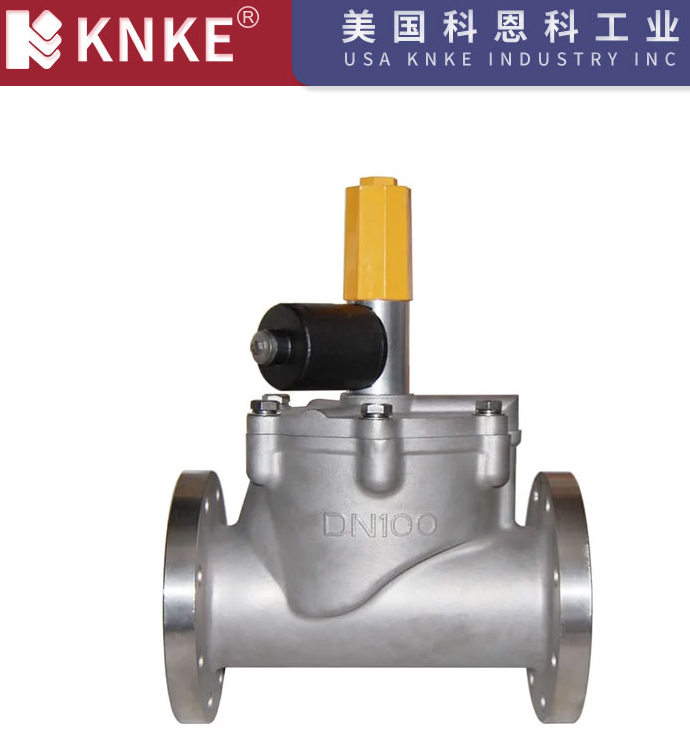Difference Between Pilot-Operated and Direct-Acting Solenoid Valves
Solenoid valves play a crucial role in controlling the flow of fluids or gases in automation systems. Based on their operating principles, solenoid valves can be divided into several types, with the pilot-operated solenoid valve and the direct-acting solenoid valve being two of the most common. While both types rely on electromagnetic force to control the movement of the valve core, they differ significantly in terms of structure, operation, application, and other factors. This article will explore the key differences between these two types of solenoid valves.
1. Operating Principles

Pilot-Operated Solenoid Valve: The pilot-operated solenoid valve works based on a two-stage control mechanism. The main valve is controlled by the solenoid via a pilot valve. When the solenoid coil is energized, it pulls the pilot valve core, changing the state of the pilot valve, which in turn controls the main valve. The pilot valve acts as an auxiliary component, adjusting the pressure to control the flow of the fluid. The advantage of this design is that it allows a smaller solenoid to control a larger flow rate.
Direct-Acting Solenoid Valve: The direct-acting solenoid valve has a simpler working principle. The solenoid directly controls the valve core, which opens or closes the fluid passage. When current flows through the solenoid, it generates a magnetic field that attracts the valve core, thereby controlling the flow. Unlike pilot-operated valves, direct-acting solenoid valves do not use a pilot valve and operate on a single stage control mechanism. This makes them suitable for smaller flow applications.
2. Structural Differences
Pilot-Operated Solenoid Valve: A pilot-operated solenoid valve consists of several components, including a solenoid, pilot valve, and main valve. The presence of the pilot valve allows the valve to operate effectively under high pressure and large flow conditions. The pilot valve regulates the flow and pressure to control the main valve’s operation.
Direct-Acting Solenoid Valve: A direct-acting solenoid valve is much simpler in structure, comprising only a solenoid and valve core. The solenoid directly actuates the valve core to control the fluid passage. This simplicity makes direct-acting solenoid valves cost-effective but less suitable for high-pressure and large flow applications.
3. Applications
Pilot-Operated Solenoid Valve: Due to its ability to handle larger flow rates and higher pressures, the pilot-operated solenoid valve is widely used in industrial automation systems, pneumatic and hydraulic applications, and other high-demand fields. It can efficiently control large flow rates with relatively low power consumption.
Direct-Acting Solenoid Valve: Direct-acting solenoid valves are ideal for applications with smaller flow rates and lower pressures. They are commonly used in household appliances, precise instruments, and small-scale systems. Their simple structure makes them affordable, but they are not suited for high-pressure or large-flow situations.
4. Response Speed
Pilot-Operated Solenoid Valve: Pilot-operated solenoid valves tend to have slower response times because the main valve’s operation is indirectly controlled through the pilot valve. The time required for the pilot valve to change states affects the overall response speed.
Direct-Acting Solenoid Valve: Direct-acting solenoid valves offer faster response times since the solenoid directly controls the valve core. This makes them suitable for applications requiring quick actuation.
5. Power Consumption
Pilot-Operated Solenoid Valve: The pilot-operated solenoid valve consumes less power because the solenoid only needs to operate the smaller pilot valve. Even when handling larger flow rates, this type of valve is more energy-efficient.
Direct-Acting Solenoid Valve: Direct-acting solenoid valves require more power because the solenoid must directly operate the valve core, especially in high-pressure environments. This leads to higher power consumption.
6. Price Difference
Pilot-Operated Solenoid Valve: Due to their more complex structure, pilot-operated solenoid valves are generally more expensive than direct-acting valves.
Direct-Acting Solenoid Valve: With their simpler design, direct-acting solenoid valves are more cost-effective, making them an affordable option for smaller applications.
Conclusion
Both pilot-operated and direct-acting solenoid valves have their distinct advantages and are suited for different applications. When selecting a solenoid valve, it is important to consider factors such as flow rate, pressure, response speed, power consumption, and cost. Pilot-operated solenoid valves are ideal for large flow and high-pressure applications, offering energy efficiency and precise control, while direct-acting solenoid valves are best for smaller flow, low-pressure applications, providing fast response times and lower costs. Understanding the differences between these two types will help you make an informed decision based on your specific needs.
